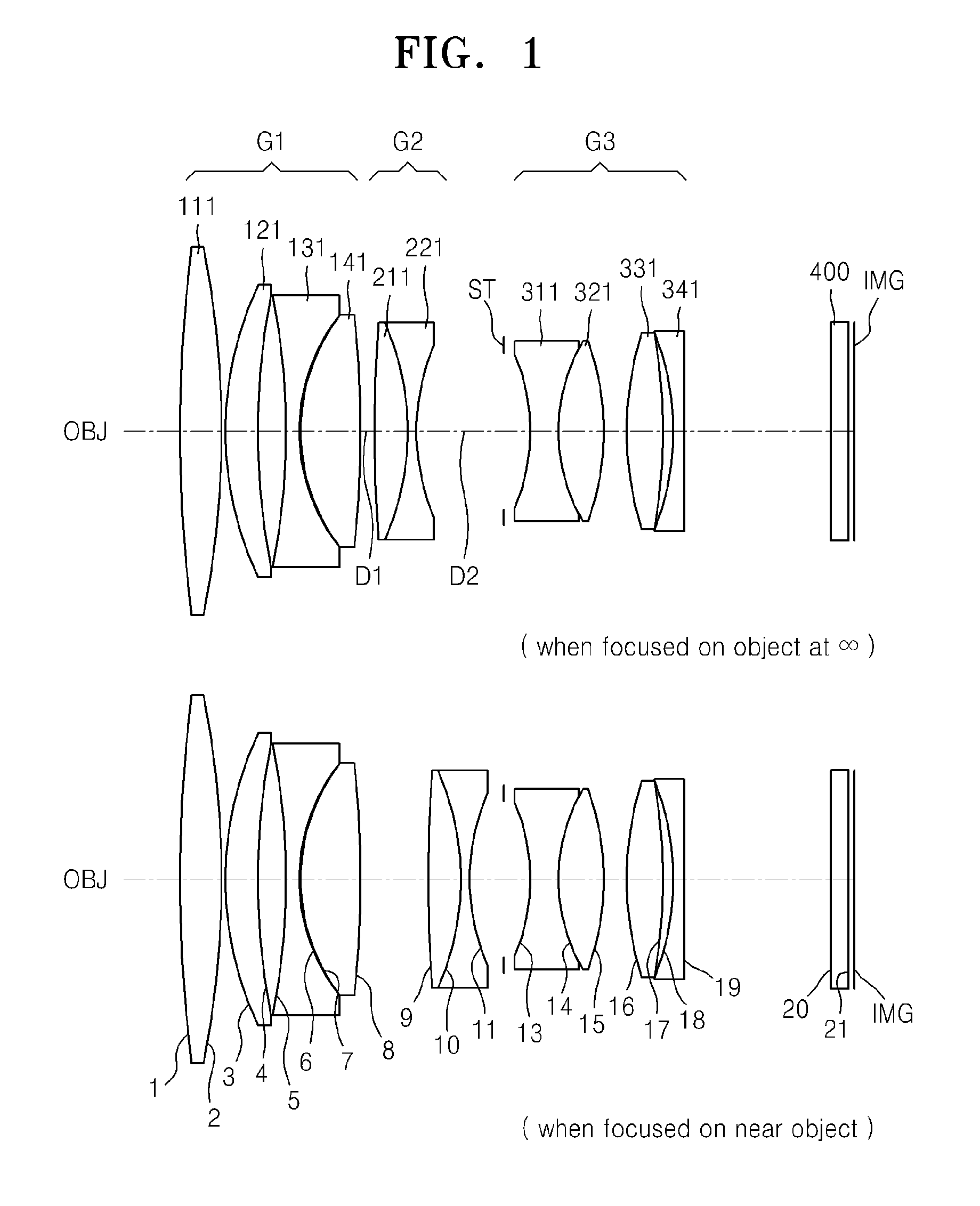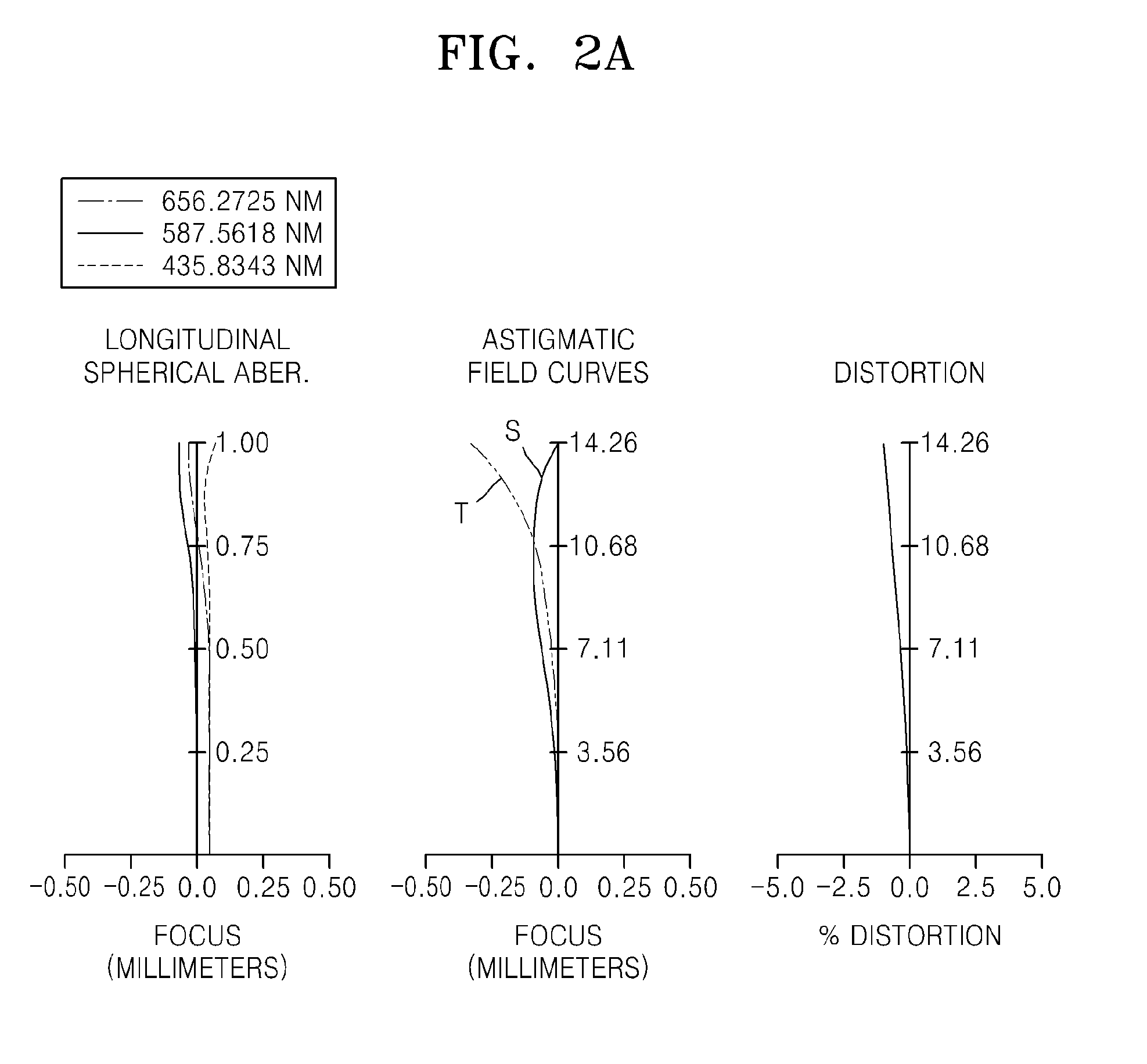Telephoto lens system
a telephoto lens and telephoto technology, applied in the field of photography lenses, can solve the problems of not providing a bright and light weight lens, slow focusing speed in the camera having an auto-focusing function, and not satisfying in brightness
- Summary
- Abstract
- Description
- Claims
- Application Information
AI Technical Summary
Benefits of technology
Problems solved by technology
Method used
Image
Examples
first embodiment
[0055]FIG. 1 shows optical arrangements in the telephoto system according to an embodiment, when the lens is focused on an object that is located far from the lens (i.e., at infinity), and when the lens is focused on an object located close to the lens (i.e., at a minimum focusing distance). The telephoto system includes the first lens group G1 having a positive refractive power, the second lens group G2 having a negative refractive power, and the third lens group G3 having a positive refractive power. The first lens group G1 includes a first lens 111 that is a positive lens, a second lens 121 that is a positive lens, a third lens 131 that is a negative lens, and a fourth lens 141 that is a positive lens. The second lens group G2 includes a fifth lens 211 that is a positive lens and a sixth lens 221 that is a negative lens. The fifth lens 211 and the sixth lens 221 form a cemented lens by bonding to each other. The third lens group G3 includes a seventh lens 311 that is a negative l...
second embodiment
[0059]FIG. 3 shows optical arrangements in the telephoto system according to another embodiment, when the lens is focused on an object that is located far from the lens (i.e., at infinity), and when the lens is focused on an object located close to the lens (i.e., at a minimum focusing distance). The telephoto system includes the first lens group G1 having a positive refractive power, the second lens group G2 having a negative refractive power, and the third lens group G3 having a positive refractive power. The first lens group G1 includes a first lens 112 that is a positive lens, a second lens 122 that is a positive lens, a third lens 132 that is a negative lens, and a fourth lens 142 that is a positive lens. The second lens group G2 includes a fifth lens 212 that is a positive lens and a sixth lens 222 that is a negative lens. The fifth lens 212 and the sixth lens 222 form a cemented lens by bonding to each other. The third lens group G3 includes a seventh lens 312 that is a negat...
third embodiment
[0062]FIG. 5 shows optical arrangements in the telephoto system according to another embodiment, when the lens is focused on an object that is far from the lens (i.e., at infinity), and when the lens is focused on an object located close to the lens (i.e., at a minimum focusing distance). The telephoto system includes the first lens group G1 having a positive refractive power, the second lens group G2 having a negative refractive power, and the third lens group G3 having a positive refractive power. The first lens group G1 includes a first lens 113 that is a positive lens, a second lens 123 that is a positive lens, a third lens 133 that is a negative lens, and a fourth lens 143 that is a positive lens. The second lens group G2 includes a fifth lens 213 that is a positive lens and a sixth lens 223 that is a negative lens. The fifth lens 213 and the sixth lens 223 form a cemented lens by bonding to each other. The third lens group G3 includes a seventh lens 313 that is a negative lens...
PUM
 Login to View More
Login to View More Abstract
Description
Claims
Application Information
 Login to View More
Login to View More - R&D
- Intellectual Property
- Life Sciences
- Materials
- Tech Scout
- Unparalleled Data Quality
- Higher Quality Content
- 60% Fewer Hallucinations
Browse by: Latest US Patents, China's latest patents, Technical Efficacy Thesaurus, Application Domain, Technology Topic, Popular Technical Reports.
© 2025 PatSnap. All rights reserved.Legal|Privacy policy|Modern Slavery Act Transparency Statement|Sitemap|About US| Contact US: help@patsnap.com



